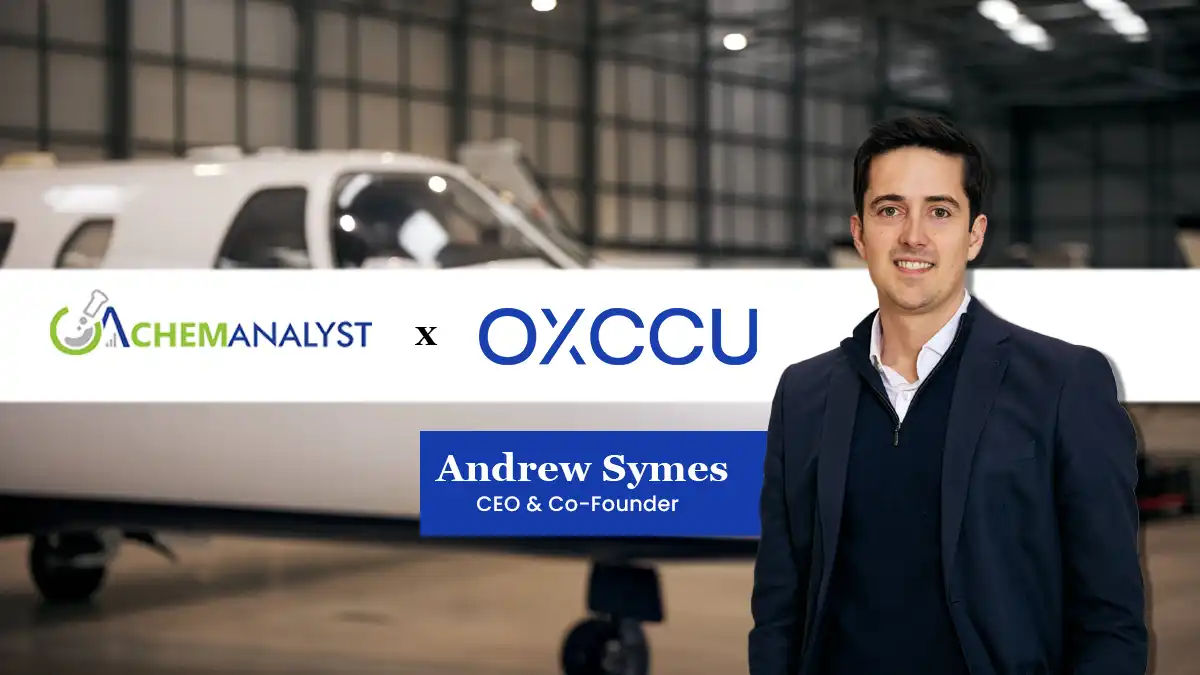Welcome To ChemAnalyst

Their innovative technology converts CO2 and feedstock directly into Jet Fuel.
Sustainable aviation fuel (SAF) has emerged as a key solution to decarbonizing the aviation sector, but scaling production efficiently and cost-effectively remains a hurdle. OXCCU, a spin-off from the University of Oxford, is tackling this challenge head-on with its innovative Fischer–Tropsch-based technology that converts CO2 and waste feedstocks directly into jet fuel.
In a recent interview, Andrew Symes, CEO and Co-founder of OXCCU, shared insights on the company’s latest $28 million Series B funding, their breakthrough technology, and how SAF production can scale sustainably to meet global demand. From differentiating their approach from other SAF pathways to addressing feedstock, cost, and regulatory challenges, Symes provides a clear roadmap for the future of aviation fuel.
Find the conversation below:
Q1: Could you tell us about your recent funding round and how you plan to expend this investment?
A: We’ve announced a $28 million Series B to build our second demonstration plant next to our existing facility at Oxford Airport. The new site is seven times larger and will help us scale production, expand lab facilities, and accelerate commercialization, aiming for a commercial-scale SAF plant by the end of the decade.
Q2: How does OXCCU differentiate itself from other SAF companies?
A: Our core innovation lies in our Fischer–Tropsch (FT) catalyst and process. Unlike traditional FT systems that only convert carbon monoxide (CO) and often produce heavier fuels, our technology can directly convert carbon dioxide (CO2) and CO into jet fuel-range hydrocarbons — eliminating additional conversion steps and improving efficiency.
Q3: For the layman, how is the Fischer–Tropsch process different from HEFA or ATJ pathways?
A: HEFA uses waste oils like used cooking oil or soybean oil, which are hydrotreated to make jet fuel, but feedstock availability is limited.
ATJ converts ethanol (from corn or other crops) into jet fuel but isn’t fully scalable since it relies on food-based feedstocks.
In contrast, our FT process can use genuine waste sources (biogas, lignin, cellulose, or captured CO2) and directly produce jet fuel with fewer steps, lower emissions, and better economics.
Q4: Would you call this an upgraded version of Fischer–Tropsch?
A: Exactly. It builds on traditional iron-based FT catalysts used historically for coal-to-liquids, but we’ve adapted it to handle high CO2 streams and target jet fuel selectively — making it far more efficient and sustainable.
Q5: Beyond aviation, what other industries could use your CO2-to-fuel technology?
A: Our process also produces naphtha, which can be used in chemical and plastic manufacturing. This helps decarbonize both aviation and petrochemical sectors, promoting carbon circularity.
Q6: Can CO2 captured from industrial sites be used for SAF production?
A: Yes, but it depends on regulatory approval. In the UK and EU (until 2041), industrial CO2 is acceptable. Using it doubles carbon utilization — giving each carbon atom two uses before release. Purity and source matter; ethanol, ammonia, and natural gas plants provide the best CO2 streams, while post-combustion CO2 is too impure and costly to purify.
Q7: Your process uses electricity for gasification. How sustainable is that if the grid isn’t fully green?
A: Even partial electrification reduces emissions compared to burning fossil fuels. The greener the grid, the better — but even moderate renewables significantly improve carbon intensity.
Q8: So, your technology is scalable only in regions with abundant renewable energy?
A: Not necessarily. It depends on the feedstock. For biogas-to-SAF, electricity use is relatively low, so it’s feasible even in regions without a fully green grid.
Q9: From an operator’s perspective, how do airlines choose between different SAF pathways?
A: They don’t need to. All SAFs are blended and must meet ASTM safety standards. Airlines receive Jet A-1 fuel that performs identically, regardless of the production route.
Q10: Will aircraft require modifications to use 100% SAF in the future?
A: No major changes are needed. Current engines can already use SAF. The only potential adjustment may be to reduce aromatic content in fuels, but that’s minor compared to retrofits in other industries like shipping.
Q11: Global SAF demand is expected to fall short by 23 million tonnes by 2035. What’s driving this gap?
A: Two main challenges: feedstock availability and technology cost. We need scalable solutions using genuine waste — not crops — and efficient processes that reduce conversion steps and capital costs.
Q12: Which of these challenges can be solved fastest?
A: They must be solved together. Once we have cost-effective technology for real waste feedstocks, financing and regulation will naturally follow.
Q13: Do you think the UK SAF mandate announced last year will be as strict as the EU SAF mandate?
A: RefuelEU is a fairly stringent regulation, but its impact depends on the buyout prices. If those prices are too low, the policy may not deliver the desired results. However, the mechanism that increases penalties over time should help strengthen its effectiveness.
Overall, it’s a significant piece of regulation that sends a strong signal to the industry: aviation needs a solution, and we must start scaling SAF technologies now. Delaying action would make it much harder to reach higher blend targets later.
Q14: How do you envision the aviation industry in the next decade?
A: SAF will start small — around 1–5% blend ratios — but scale rapidly. The availability of waste CO2, wood, straw, and biogas gives massive potential. Like wind and solar, SAF will grow from niche to mainstream and eventually reshape the petrochemical landscape.
Q15: What’s next for OXCCU?
A: Our priority is completing OX2, our next demo plant, by the end of next year and moving toward commercial-scale production soon after. We’re evaluating multiple sites globally — more on that soon.
We use cookies to deliver the best possible experience on our website. To learn more, visit our Privacy Policy. By continuing to use this site or by closing this box, you consent to our use of cookies. More info.
